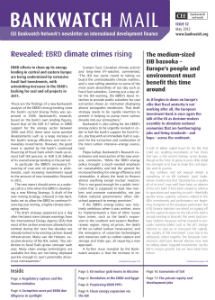Health and safety on the line in ArcelorMittal’s Kazakh operations

Bankwatch Mail | 14 May 2012
The EBRD’s development of a new Mining Strategy saw the publication last month of a draft that will now be consulted on. Among the passages in the draft to catch the eye are “Multi-national firms act as demonstrators of best (or at least better) practices in those EBRD countries of operations where EHS&S (Environmental, health, safety and social) legislation is lacking”, and that “investments by major international mining operators in local mining sites in the EBRD’s countries of operations have often led to rapid and significant improvements in the safety of workers, due to safety standards that generally exceed the most stringent local health and safety requirements”.
This may come as news to those who work at or monitor ArcelorMittal’s coal mines in the Karaganda region of Kazakhstan. The steel giant owns eight coal mines in the region along with an integrated steel plant in Termirtau, iron ore mines and power generation assets. In 2007 the EBRD financed the USD 100 million Mittal Steel Temirtau – Coal Mine Modernisation Project.
Over the last nine years, 107 miners have died in the ArcelorMittal Temirtau (AMT) owned coal mines in Karaganda region as a result of accidents involving methane explosions, coal failures and gas blowouts. The most recent fatal accident saw the death of a miner on April 20 this year at the Kazakhstanskaya coal mine. In August 2011, two workers were killed at the Kuzembayeva coal mine following a gas blowout.
AMT has long been accused by its workers and the Kazakh government for the high rate of industrial injuries and its approaches to health and safety that bring about unsafe working conditions for miners. ATM counters with health and safety data that apeears to show progress in reducing injuries and deaths at the steelworks, coal mines and iron ore mines. However, the injury data has been questioned by statements from miners that some occupational injuries are misclassified as domestic injuries.
ATM downsizing is also felt to be having an impact on mine safety. Since ATM’s acquisition of the coal mines in 1995, the number of workers at the coal mines has been reduced from 40,000 to 20,000. These efficiency measures have lead to miners reporting having to work on tasks for which they are not qualified or that are supposed to be covered by others. In addition to the pressures attributed to the lack of miners, cases have been identified in the Tentekskaya and Kazakhstanskaya mines where safety procedures are overridden in order to avoid work stoppages.
Violations of labour legislation, including the enforcement of extra overtime, have lead to a joint declaration from trade unions at AMT and at the company’s operations at Kriviy Rih in Ukraine where experiences are similar. The unions have said: “Together we’ll be able to more effectively stand up against the transnational company’s rampant pursuit of income. This pursuit often entails infringement of employees’ rights, deterioration of their working and living conditions, groundless job cuts, violation of social standards, pressure on trade unions and attempts to reduce the scope of their activities”.
Theme: Social & economic impacts | Mining
Location: Kazakhstan | Ukraine
Project: ArcelorMittal Kryvyi Rih, Ukraine | ArcelorMittal Temirtau, Kazakhstan | Steel giant ArcelorMittal
Tags: BW Mail 52
Never miss an update
We expose the risks of international public finance and bring critical updates from the ground. We believe that the billions of public money should work for people and the environment.
STAY INFORMED
